

"As an invention it is very old. It was in use in the days
of Pythagoras, about 540 B.C. According to a French
historical account of the philosopher's life, his sect held
frequent séances or circles at which a mystic table, moving
on wheels, moved towards signs, which the philosopher and
his pupil, Philolaus, interpreted to the audience as being
revelations supposedly from the unseen world."
-Encyclopedia of Psychic Science
Writers of occult literature love to talk about the Ouija board's ancient roots. Ouija boards, they tell us, were in use in ancient Greece, Rome, China, or whatever other cultures the authors deem important. They steadfastly maintain that modern Ouija boards are the direct descendants of its more primitive ancestors. If the ancestor wasn't a Ouija board exactly, it was "Ouija-like." This can mean that almost any early divination device qualifies. Few question this and new writers repeat the words of the old without thinking critically about it. Ancient Ouija boards: fact or fiction? Let's take a look.
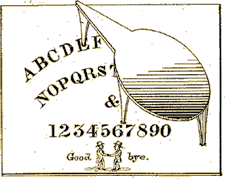 The term Talking board is
the original designation for a message board with numbers,
letters, and a movable pointer. You may also know it as a
spirit board, witch board, oracle
board, or most recently, channeling board. Most
recognize it by its most popular name—Ouija board.
The word Ouija is Hasbro's trademarked name for
Parker Brothers' talking board set. Hasbro, at the time of
this writing, owns Parker Brothers. Originally,
Ouija was the name chosen by patent holder Elijah
Bond, and assigned to Kennard Novelty Company's 1890 parlor
game. The Ouija board operates in a strange and mysterious
manner. Lightly touched by one or more participants, a
special pointer slides or pivots along the surface of the
board to spell out supernatural messages. Hence, the name
talking board. These messages may instruct, warn,
give council, or foretell the future and in this way, the
unknown becomes known. During the session, some users
believe that they are communicating with the spirits of the
dead and that the board opens a direct channel between the
sitters and the inhabitants of the spirit world.
The term Talking board is
the original designation for a message board with numbers,
letters, and a movable pointer. You may also know it as a
spirit board, witch board, oracle
board, or most recently, channeling board. Most
recognize it by its most popular name—Ouija board.
The word Ouija is Hasbro's trademarked name for
Parker Brothers' talking board set. Hasbro, at the time of
this writing, owns Parker Brothers. Originally,
Ouija was the name chosen by patent holder Elijah
Bond, and assigned to Kennard Novelty Company's 1890 parlor
game. The Ouija board operates in a strange and mysterious
manner. Lightly touched by one or more participants, a
special pointer slides or pivots along the surface of the
board to spell out supernatural messages. Hence, the name
talking board. These messages may instruct, warn,
give council, or foretell the future and in this way, the
unknown becomes known. During the session, some users
believe that they are communicating with the spirits of the
dead and that the board opens a direct channel between the
sitters and the inhabitants of the spirit world.
When discussing talking boards in any detail, it is important to know what they are and what they are not. The other most common and widely known devices in the same divination class as talking boards are: divining rods, planchettes, tables used for table tipping (table turning), and pendulum oracles. Let's look at each one.
 A divining or dowsing rod is a rod, branch, or
twig that the dowser holds horizontally to find buried
water or a variety of other hidden things. The rod or
rods—when there is one in each hand, dip over the hidden
object but may also respond to direct questions by moving
one way for yes, and the other for no. Some dowsers or
water witches also believe that they can use their
skills to find missing people or diagnose diseases.
A divining or dowsing rod is a rod, branch, or
twig that the dowser holds horizontally to find buried
water or a variety of other hidden things. The rod or
rods—when there is one in each hand, dip over the hidden
object but may also respond to direct questions by moving
one way for yes, and the other for no. Some dowsers or
water witches also believe that they can use their
skills to find missing people or diagnose diseases.
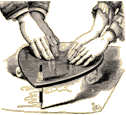 A planchette (plan-'shet), also known as an
automatic writer, is a small board supported by two wheels
at one end and a pencil at the other making the third leg.
The planchette writes messages when lightly touched by one
or more users. Remove the wheels and the pencil and the
planchette becomes the familiar Ouija board pointer.
Planchettes may be any shape but are most often
heart-shaped to take advantage of the point as an
indicator.
A planchette (plan-'shet), also known as an
automatic writer, is a small board supported by two wheels
at one end and a pencil at the other making the third leg.
The planchette writes messages when lightly touched by one
or more users. Remove the wheels and the pencil and the
planchette becomes the familiar Ouija board pointer.
Planchettes may be any shape but are most often
heart-shaped to take advantage of the point as an
indicator.
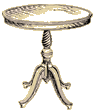 Tables used for table tipping (table turning), are
normal tables like you have in your own home. Sitters place
their hands on the table and it tips to specific letters of
the alphabet spelling out messages from the spirits. Early
Spiritualists chose the table as a divination device
because it was a common piece of furniture and that made it
perfect for home circles or meetings. One member of the
group would call out the letters of the alphabet or hold up
an alphabet card and run a finger over it. The table would
tip and knock at the chosen letter.
Tables used for table tipping (table turning), are
normal tables like you have in your own home. Sitters place
their hands on the table and it tips to specific letters of
the alphabet spelling out messages from the spirits. Early
Spiritualists chose the table as a divination device
because it was a common piece of furniture and that made it
perfect for home circles or meetings. One member of the
group would call out the letters of the alphabet or hold up
an alphabet card and run a finger over it. The table would
tip and knock at the chosen letter.
![]() A pendulum oracle is a thread, rope, or cord held
by the fingers with a connected hanging weight at the end.
It swings back and forth to answer yes and no questions or
to find hidden objects. It can have any kind of weight but
it is often a crystal or ring. One method of operation is
to hold the pendulum in the mouth of a glass. The pendulum
strikes the inside of the glass to answer questions. Expert
readers believe that they can gain productive information
from the faintest pendulum movements.
A pendulum oracle is a thread, rope, or cord held
by the fingers with a connected hanging weight at the end.
It swings back and forth to answer yes and no questions or
to find hidden objects. It can have any kind of weight but
it is often a crystal or ring. One method of operation is
to hold the pendulum in the mouth of a glass. The pendulum
strikes the inside of the glass to answer questions. Expert
readers believe that they can gain productive information
from the faintest pendulum movements.
As you can see, these divination devices each have their own special characteristics. Put them next to one another and you can easily distinguish between them. What connects them in a class is that they all facilitate messaging, regardless of whether you think the messages are natural or supernatural, and they all require the same hands-on engagement. Unfortunately, people frequently mistake one for the other, particularly when discussing the history of the talking board. This is why you may read that Ouija boards date to ancient Greece or China or Rome. A talking board is unique because of the sliding message indicator and spelling board configuration. Although commonly confused and lumped in with talking boards, it's important to remember that the other instruments are not the same, even if they produce similar results. Think of it this way: a car and a horse will both get you to the store because they are methods of transportation. If you call your car a horse, people will think it a bit odd. If you see the alphabet, words, or symbols that can be translated into sentences or coherent messages and you get to them using a hands-on sliding or rolling message indicator, you have a talking board. Otherwise, it is something else. Since talking boards come in different patterns and fancy names, you may have to look closely. A talking board is a talking board no matter how plain or embellished or constructed. Makers may scrawl one on a wall or fashion it from metal or stone. All function in a similar fashion.
The practice of obtaining secret knowledge through supernatural means is as old as humankind, or nearly so. Divination by shamans and seers was a staple of most ancient civilizations. While we no longer predict the future by sifting through bird droppings and animal entrails, there is still a thriving market for popular forms of fortune telling like astrology, tarot, the I Ching, palmistry, and the Ouija board. When we search the distant past for ancient talking boards we simply don't find any, despite claims to the contrary. Talking boards are unique to the Spiritualist movement of the 1800's. Not so for the other divination instruments writers often mistake for Ouija boards. The pendulum oracle described by fourth-century Roman historian, Ammianus Marcellinus, in his The Later Roman Empire (A.D. 354-378), is the most notable example and is often offered as proof that talking boards existed in ancient civilizations. In Marcellinus' narrative, two unfortunate individuals, Patricius and Hilarius are under arrest for creating an oracle to define who would succeed the emperor. They plead before the court:
My lords, in an unlucky moment we put together out of laurel twigs in the shape of the Delphic tripod the hapless little table before you. We consecrated it with cryptic spells and a long series of magical rites, and at last made it work. The way in which it did so, when we wished to consult it about hidden matters, was this. It was placed in the middle of a room thoroughly fumigated with spices from Arabia, and was covered with a round dish made from the alloys of various metals. The outer rim of the dish was cunningly engraved with the twenty-four letters of the alphabet separated by accurate intervals. A man dressed in linen garments and wearing linen sandals, with a fillet around his head and green twigs from a lucky tree in his hand, officiated as priest. After uttering a set prayer to invoke the divine power which presides over prophecy, he took his place above the tripod as his knowledge of the proper ritual had taught him, and set swinging a ring suspended by a very fine cotton thread which had been consecrated by a mystic formula. The ring, moving in a series of jumps over the marked spaces, came to rest on particular letters, which made up hexameters appropriate to the questions put and in perfect scansion and rhythm, like the lines produced at Delphi or by the oracle of the Branchidae.
Circumstances did not go well for Patricius and Hilarius after the inquisition: "both the accused were fearfully mangled by the torturers hooks and taken away unconscious." This is a wonderful example of an ancient alphabet oracle in the same divination class as talking boards but it is clearly a pendulum oracle. As we mentioned earlier, pendulum divination uses a hanging, swinging weight as a message indicator. It does not slide or pivot across the surface of a board and that's an important distinction. That doesn't mean that you can't use a pendulum over a talking board but once you do, it becomes a pendulum oracle and it is no longer a talking board. Non-believers may say that there is no supernatural intervention and that you are moving the pendulum or the divining rod yourself. Therefore, they are the same. This is a basic misunderstanding and has nothing to do with the operation of the devices. You shoot a gun and you shoot a bow and arrow but you can't mistake one for the other.
This early account of an ancient Ouija board from Lewis Spence's, An Encyclopedia of Occultism (1920), is sited so often that many commonly accept it as fact:
Another form is the Ouija board on which in a convenient order the letters of the alphabet are printed and over which a pointer easily moves under the direction of the hand of the person or persons acting as mediums It is stated that a form of this mystic toy was in use in the days of Pythagoras about 540 BC. In a French history of Pythagoras the author describing his celebrated school of philosophy asserts that the brotherhood held frequent séances or circles at which a mystic table moving on wheels moved towards signs inscribed on the surface of a stone slab on which the moving table worked.
This might be of interest except that Spence does not name the French author who makes this statement and no research of Pythagoras, who left no written record, speaks of a mystic table on wheels. There are no divination devices of the period that fit this description. With no evidence to support such a claim we have to wonder. Spence also tells us “in 1853, a well-known French spiritualist, M. Planchette, invented this instrument to which he gave his name.” The word “planchette” is French for “little board” and there is no record of a French spiritualist named “M. Planchette,” odd because Spence describes him as “well-known.” Again, we have to draw our own conclusions.
In 1934, Nandor Fodor borrowed heavily from Spence and published his Encyclopedia of Psychic Science. His description of the Ouija board sounds very familiar with an interesting addition:
As an invention it is very old. It was in use in the days of Pythagoras, about 540 B.C. According to a French historical account of the philosopher's life, his sect held frequent séances or circles at which a mystic table, moving on wheels, moved towards signs, which the philosopher and his pupil, Philolaus, interpreted to the audience as being revelations supposedly from the unseen world.
Now we read that Pythagoras with his pupil Philolaus held séances and officiated as seers. Although dates are foggy for this period, history tells us that Philolaus was born long after the death of Pythagoras and that he wasn't one of his students. It's surprising so few writers have caught this but it is an example of how misinformation and misclassification passes from one to the other and is further compounded.
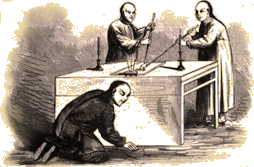 Stoker Hunt writes in his Ouija the Most
Dangerous Game (1985): "In China, centuries before the
birth of Confucius (551? -479 B.C.), the use of Ouija-like
instruments was commonplace, considered a nonthreatening
way to communicate with the spirits of the dead."
"Ouija-like" can be confusing. It's an easy way to lump all
divination devices in the same group and it is historically
inaccurate if you fail to clarify distinctions. What he is
talking about is a form of Chinese spirit writing (Fu Chi,
Fuji). Some Chinese mystics believe that a divine spirit
can take possession of a writing brush or a writing tool
similar to the western planchette. Opinions vary among
historians about the age of this practice, but it is
undoubtedly very old. This is clearly automatic writing.
You could call this type of divination planchette writing
if you insist on using the French name for a Chinese
writing device, but it is not a talking board.
Stoker Hunt writes in his Ouija the Most
Dangerous Game (1985): "In China, centuries before the
birth of Confucius (551? -479 B.C.), the use of Ouija-like
instruments was commonplace, considered a nonthreatening
way to communicate with the spirits of the dead."
"Ouija-like" can be confusing. It's an easy way to lump all
divination devices in the same group and it is historically
inaccurate if you fail to clarify distinctions. What he is
talking about is a form of Chinese spirit writing (Fu Chi,
Fuji). Some Chinese mystics believe that a divine spirit
can take possession of a writing brush or a writing tool
similar to the western planchette. Opinions vary among
historians about the age of this practice, but it is
undoubtedly very old. This is clearly automatic writing.
You could call this type of divination planchette writing
if you insist on using the French name for a Chinese
writing device, but it is not a talking board.
Ouija the Most Dangerous Game continues with, "In thirteenth-century Tartary, the Mongols used Ouija-like instruments for purposes of divination and instruction." Although uncredited, this comes directly from Epes Sargent's book, Planchette; or The Despair of Science (1869): "According to Huc, the Catholic missionary, table-rapping and table-turning were in use in the thirteenth century among the Mongols, in the wilds of Tartary. The Chinese recognize spiritual intervention as a fact, and it is an element in their religious systems." Evariste Régis Huc was a French missionary of the Vincentian order who traveled throughout China for several years in the 1840's sometimes disguised as a Tibetan Llama. His popular account of his adventures Souvenirs d'un voyage dans la Tartarie was widely read and reprinted. According to Daniel MacGowan, a medical missionary during the same time, Huc claimed that "table-rapping and table-turning were, at that period, familiar to the Mongols in the wilds of Tartary, and that the soothsayers frequently asked the spirits by the sound of the tambourine." This is intriguing because it asserts that table tipping and spirit tambourines, both a part of American Spiritualist séances, were common in China hundreds of years before the birth of modern Spiritualism. When we read Huc's own words in his Christianity in China, Tartary and Thibet (Volume 1-1857) we gain an entirely different understanding:
If they wished to ruin any one, they had nothing to do but to accuse him of having by his malignant arts occasioned any misfortune that might have occurred. When they were interrogated, they evoked their demons by the sound of the tambourine, shaking it furiously; then falling into an ecstasy, they feigned to receive answers from their familiar spirits, and proclaimed them as oracles. It is rather curious, too, that table-rapping and table-turning were in use in the thirteenth century among these Mongols in the wilds of Tartary. Rubruk himself witnessed an instance of the kind. On the eve of the Ascension, when the mother of Mangou feeling very ill, the first soothsayer was summoned for consultation, he "performed some magic by rapping on a table."
This sounds nothing like American Spiritualism. During American séances, the tambourine was not used by the officiating medium but by the spirit to signal its presence. This was exposed many times as trickery but it doesn't relate in any way to the way the Mongols used it—to evoke demons. To Huc, the performance of magic by "rapping on a table" was comparable to table rapping and table turning in the West. The actions of rapping on a table and a table knocking on the floor or turning under the fingers during a séance, are entirely different. This may have been a simple mistake for Huc whose interests were more Chinese than American but we can dig a little deeper. Huc mentions William Rubruck, a Flemish Franciscan monk who traveled for three years throughout the southern steppes, now Russia and Ukraine, in the mid 13th century. Rubruck wrote a detailed and famous account of his travels and experiences in, The Journey of William Rubruck to the Eastern Parts of the World 1253-55. It is from this journal that Huc cites. Rubruck tells of treacherous soothsayers, of Mangu Chan's terminally ill mother, and of Nestorian priests who, "strike a board and chant their offices." The priests struck boards with mallets instead of bells during worship and this is most likely where Huc went astray. Nowhere in any of Rubruck's current translations does it mention soothsayers rapping on a table. Not having the resources available to us today, perhaps Huc the missionary read Rubruck in Latin and simply confused the words pulsant tabulam, "struck board" with "struck table." In any event, it is interesting that over one hundred and fifty years later, writers still quote Huc when assigning the Ouija board ancient roots.
So, were there ancient Ouija boards? Until one shows up in an archaeology dig, the evidence is lacking. To be an ancestor of something, there must be a connection, evolution, or at least some influence. The instrument has to have been in wide enough use to connect to the popular imagination. As relationships go, the talking boards of today grew out the use of the alphabet and alphabetic pasteboards during 19th century spiritualistic séances and not from pendulum oracles or other devices used many centuries earlier.
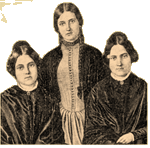 In 1848, the Fox sisters realized immediately
that calling out the individual letters of the alphabet,
and having the spirits knock accordingly, was easier than
asking lengthy "yes-no" questions. The use of alphabet
pasteboards became common among table-tippers who came to
the same conclusion. And there were mediums who didn't wait
for the spirits to knock but instead relied on a kind of
divine intuition: "During a communication between the
medium and the supposed spirit, the former passed his hand
over the alphabet, until he found his finger sensibly and
irresistibly arrested at a certain letter, and so on, until
the word, the sentence, was completed." The Rappers
(1854).
In 1848, the Fox sisters realized immediately
that calling out the individual letters of the alphabet,
and having the spirits knock accordingly, was easier than
asking lengthy "yes-no" questions. The use of alphabet
pasteboards became common among table-tippers who came to
the same conclusion. And there were mediums who didn't wait
for the spirits to knock but instead relied on a kind of
divine intuition: "During a communication between the
medium and the supposed spirit, the former passed his hand
over the alphabet, until he found his finger sensibly and
irresistibly arrested at a certain letter, and so on, until
the word, the sentence, was completed." The Rappers
(1854).
Starting in the 1850's, alphabet boards made the transition to the dial-plate instruments, also known as psychographs, first in the United States and then in Europe. The first talking board with a detachable sliding message indicator appeared around 1886. That's a short thirty-eight year time frame. These are the real relatives of the Ouija board. They are the devices of this period: the talking tables, the alphabet pasteboards, and the early dial-plate instruments.
Site
Map | Main | FAQ | History | Directions | Theories | Stories | Gallery
Ouija-stitions | Interactive | Books | Movies |
Collect | Buy
| Links | e-mail
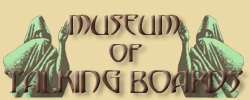
You are visiting the Museum of Talking Boards
Copyright © All Rights Reserved.